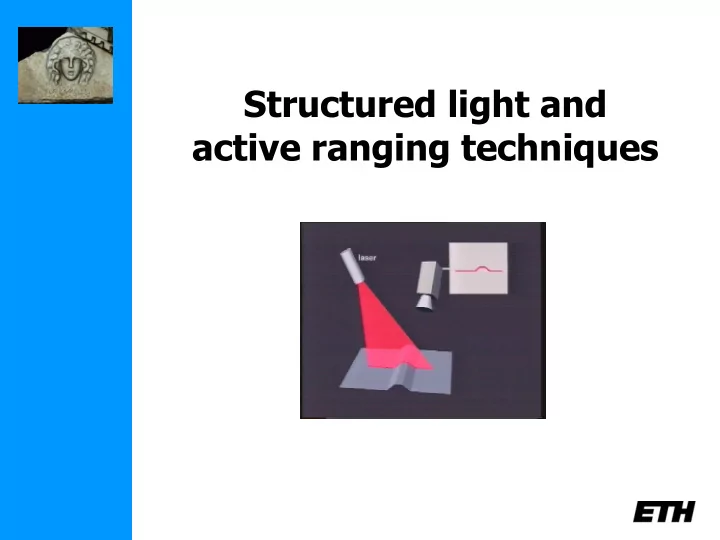

Structured light and active ranging techniques
3D photography course schedule Topic Feb 21 Introduction Feb 28 Lecture: Geometry, Camera Model, Calibration Mar 7 Lecture: Features & Correspondences Mar 14 Project Proposals Mar 21 Lecture: Epipolar Geometry Mar 28 Depth Estimation + 2 papers Apr 4 Single View Geometry + 2 papers Apr 11 Active Ranging and Structured Light + 2 papers Apr 18 Project Updates Apr. 25 --- Easter --- May 2 SLAM + 2 papers May 9 3D & Registration + 2 papers May 16 Structure from Motion + 2 papers May 23 Shape from Silhouettes + 2 papers May 30 Final Projects (if not demo day)
Today’s class • unstructured light • structured light • time-of-flight (some slides from Szymon Rusinkiewicz, Brian Curless)
A Taxonomy
A taxonomy
Unstructured light project texture to disambiguate stereo
Space-time stereo Davis, Ramamoothi, Rusinkiewicz, CVPR’03
Space-time stereo Davis, Ramamoothi, Rusinkiewicz, CVPR’03
Space-time stereo Zhang, Curless and Seitz, CVPR’03
Space-time stereo Zhang, Curless and Seitz, CVPR’03 • results
Light Transport Constancy Davis, Yang, Wang, ICCV05
Triangulation
Triangulation: Moving the Camera and Illumination • Moving independently leads to problems with focus, resolution • Most scanners mount camera and light source rigidly, move them as a unit, allows also for (partial) pre-calibration
Triangulation: Moving the Camera and Illumination
Triangulation: Moving the Camera and Illumination (Rioux et al. 87)
Triangulation: Extending to 3D • Possibility #1: add another mirror (flying spot) • Possibility #2: project a stripe, not a dot Object Laser Camera Camera
Triangulation Scanner Issues • Accuracy proportional to working volume (typical is ~1000:1) • Scales down to small working volume (e.g. 5 cm. working volume, 50 m. accuracy) • Does not scale up (baseline too large…) • Two-line-of-sight problem (shadowing from either camera or laser) • Triangulation angle: non-uniform resolution if too small, shadowing if too big (useful range: 15 -30 )
Triangulation Scanner Issues • Material properties (dark, specular) • Subsurface scattering • Laser speckle • Edge curl • Texture embossing
Space-time analysis Curless ‘95
Space-time analysis Curless ‘95
Projector as camera
Multi-Stripe Triangulation • To go faster, project multiple stripes • But which stripe is which? • Answer #1: assume surface continuity e.g. Eyetronics’ ShapeCam
Kinect • Infrared „projector“ • Infrared camera • Works indoors (no IR distraction) • „invisible“ for human Depth Map: Color Image IR Image note stereo shadows! (unused for depth)
Kinect • Projector Pattern „strong texture“ • Correlation-based stereo between IR image and projected pattern possible Homogeneous region, stereo shadow Bad SNR / too close ambiguous without pattern
Multi-Stripe Triangulation • To go faster, project multiple stripes • But which stripe is which? • Answer #2: colored stripes (or dots)
Multi-Stripe Triangulation • To go faster, project multiple stripes • But which stripe is which? • Answer #3: time-coded stripes
Time-Coded Light Patterns • Assign each stripe a unique illumination code over time [Posdamer 82] Time Space
Better codes… • Gray code Neighbors only differ one bit
Poor man’s scanner Bouguet and Perona, ICCV’98
Pulsed Time of Flight • Basic idea: send out pulse of light (usually laser), time how long it takes to return 1 1 2 2 d d c c t t
Pulsed Time of Flight • Advantages: • Large working volume (up to 100 m.) • Disadvantages: • Not-so-great accuracy (at best ~5 mm.) • Requires getting timing to ~30 picoseconds • Does not scale with working volume • Often used for scanning buildings, rooms, archeological sites, etc.
Depth cameras 2D array of time-of-flight sensors e.g. Canesta’s CMOS 3D sensor jitter too big on single measurement, but averages out on many (10,000 measurements 100x improvement)
Depth cameras 3DV’s Z -cam Superfast shutter + standard CCD • cut light off while pulse is coming back, then I~Z • but I~albedo (use unshuttered reference view)
AM Modulation Time of Flight • Modulate light at frequency m , it returns with a phase shift 1 1 c c 2 2 n n d d 2 2 ν ν 2 2 m m • Note the ambiguity in the measured phase! Range ambiguity of 1 / 2 m n Mesa Swissranger
AM Modulation Time of Flight • Accuracy / working volume tradeoff (e.g., noise ~ 1 / 500 working volume) • “wraparound” -effect 2 π (very close/far objects!) • In practice, often used for room-sized environments (cheaper, more accurate than pulsed time of flight)
ToF Depth Cameras • + fast/synchronized depth acquisition • - limited range (~2-20m) • - So far, very limited resolution (~200x200) and very noisy
Shadow Moire
Next Monday: Project Updates !
Presentations Scharstein/Szeliski: “High Accuracy Stereo Depth Maps using Structured Light” Valkenburg/McIvor: “Accurate 3D measurement using a Structured Light System”
Recommend
More recommend